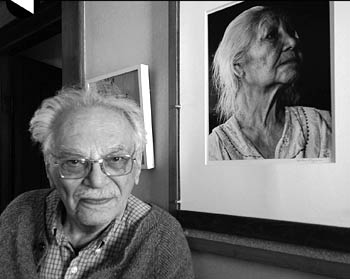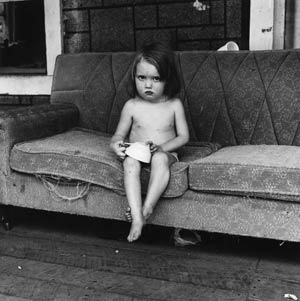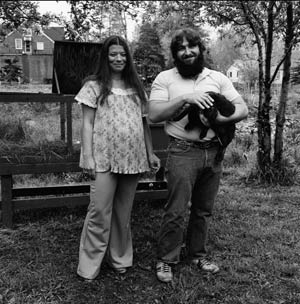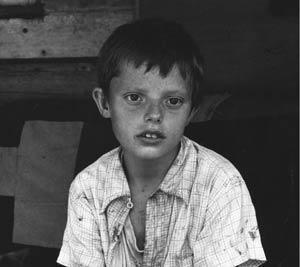
Milton Rogovin: Connecting to the Artistic Muse at 90
By Robert Hirsch
From Forever Young Magazine, August 2004

Portrait of Milton Rogovin by Robert Hirsch
|
In the early 1970s, social activist Milton Rogovin made a series of working- class people’s photographic portraits near his downtown Buffalo optical business. At the suggestion of his wife, Anne, Rogovin returned to photograph the same people in the early 1980s and again in the 1990s. The resulting photographs were published as Triptychs: Buffalo’s Lower West Side Revisited (1994) that let viewers see how the people aged, changed and endured over time. Rogovin calls the people in these photographs the “forgotten ones” because they are without power or a voice. Rogovin hoped that by photographing them he could “show the public that they were people just like us and should not be looked down on or abused in any way.” These photographs have been widely admired, collected and exhibited. What nobody knows about is Rogovin’s creative burst of energy at the age of 90 during which time he wrote poems in response to his own photographs.
On a recent visit to see his father, Mark Rogovin, who founded a Peace Museum in Chicago, said: “There is a running-joke in our family that Milton can only write poems when sitting in a certain sloped chair in his living room. I tried it, but nothing happened (laughs). Mark continues, “I think the inspiration for the poems came from my late mother, Anne Rogovin, who for 61 years was the great organizing force behind this family’s activities. I am certain that she had more extensive files on Milton than the FBI. I believe that the coupling of Milton’s words and image in such works as in This Is Our Child, America combines to make a profound statement about Appalachia.”
This Is Our Child, America (2002)
America, America
This is our child –
Our daughter, America
An empty cup
– a fragile child
Look into her eyes
They speak to us
We who bother to listen
Is this what we want
America, America?
We cannot
We must not abandon her
She will come back to
Haunt us,
America, America
|

Milton Rogovin: This is Our Child, America, Appalachia, 1962-71 |
Milton Rogovin, now almost 95 years old, told me: “I had never written a poem in my life. I was sitting in this [sloped] chair on my ninetieth birthday and I started crying as I recalled my father going swimming at Coney Island and a poem came out. Next I wrote a poem about my mother. I was remembering the time she took me to the Metropolitan Museum of Art in New York City to see a well-known painting called The Horse Fair (1852) by Rosa Bonheur.” This fascinating memory links Rogovin’s mother with one of the most famous woman artists of the first three quarters of the nineteenth century. Although many women at this time were amateur artists, it was highly unusual for a woman to pursue a career in painting. Bonheur was a proponent in direct observation of nature and wanted to be accurate in her details. To achieve this, she dissected animal parts, sketched from life, and attended horse fairs, where horse dealers showed off their stock. At hat time, women did not attend such events. To avoid the taunts that a woman might receive at a horse fair, Bonheur applied for permission from the prefecture of police to dress in men’s clothing, and received authorization to do so in 1852. The Albright-Knox Art Gallery collection has an oil study that Bonheur did in preparation of her final painting.
Milton also recollects his mother hanging a print of Vincent Van Gogh’s Sun Flowers in their living room next to pictures of his grandparents. Rogovin was fascinated by the print and later in life he studied Van Gogh’s working style, especially his genre pictures like the Potato Eaters (1885) that dealt with everyday people and reflect Van Gogh’s exceptionally subjective yet highly humanitarian outlook. Rogovin recalled a letter Van Gogh wrote to his brother Theo saying: “I have tried to emphasize that those people, eating their potatoes in the lamp-light have dug the earth with those very hands they put in the dish, and so it speaks of manual labor, and how they have honestly earned their food.” In essence it is this emphasis on personal toil that many of Rogovin’s forthright photographs, such as the ones made of Buffalo steel mill workers, bring to our attention and to meditate upon.
Trembath (2002)
There he was – sitting in a casting
No – not goofing off – just resting
A nice guy, beard and all – waiting to
have his picture taken
“Welcome to our home!”
He takes the black rabbit from the cage
There he stands next to his pregnant
wife
They’re ready for the picture –
I needn’t tell them how to stand.
Seven years have passed
They welcome us once again
Then he and his pregnant wife plus
their seven-year-old son
Stand ready for the picture
When we are leaving, the smiling wife
whispers to me
“Picture man, every time you come, I’m
pregnant.
Do me a favor – PLEASE DON’T COME AGAIN!”
|

Milton Rogovin: Trembath, Working People {Buffalo}, 1977-80 |
After these two fledgling efforts Milton began writing poems about his photographs. Rogovin says: “The poems were based on memories that I thought fit just right with certain of my photographs. Since I didn’t take up photography until I was 47, I had never taken a photograph of my father and had made only a couple of snapshots of my mother.
Mark thinks that his father’s motivation to write poetry stems from his being silenced during the McCarthy period, a time when he was branded as “Buffalo’s Top Red” and shunned by many in the community. Mark exclaims: “Milton returned to certain images because he had more to say about social/economic/environmental problems that many of the people he photographed were confronting. It is his plea not only that the photographs should speak, but his poems could articulate a little more meaning.” Mark also relates that the photographs Milton chose to write about are indicative of the ones he would pin up on their kitchen bulletin board when he was a kid for family discussion. The ones that lasted more than a couple of days were the ones that Milton then would make as final prints.
My Theme Boy (2002)
His land is dying
You can see it
in his eyes
The mines are closing
This too is in his eyes
Look into his eyes
They will tell you lots – lots more
Of mountain tops – stripped and
gouged
Of streams polluted
Of fish destroyed
Remember, America
This should be
This must be
The land of opportunity and equality
for all
Including this little boy
|

Milton Rogovin: My Theme Boy, Appalachia, 1962-71 |
Milton’s poetic period lasted about one year during which time he wrote about 75 works. Until now none of these poems and their accompanying photographs have been published together. Milton has since tried to write more poetry but “nothing happens.” Nevertheless, it was a vital time during which Rogovin achieved a personal finale with many of his significant photographs and reminds us that if we remain open to it, creativity has no age limits.
To learn more about Milton Rogovin visit: www.miltonrogovin.com
Read Robert Hirsch’s feature length interview with Milton Rogovin.
|